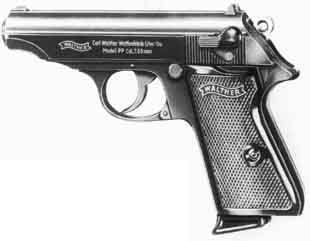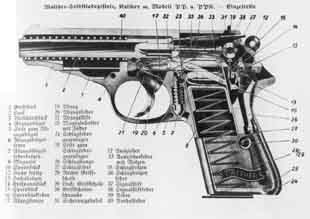WALTHER PP and PPK
Model Nation of origin: Ammunition: Operation: Weight: Length: Length of barrel: Magazine capacity: Muzzle velocity: (7.65 mm) |
PP Germany 7.65 x 11mm blowback 0.682 kg 173 mm 99 mm 8 rounds 290 m/s |
or PPK Germany 9 x 17mm blowback 0.568 kg 155 mm 86 mm 7 rounds 280 m/s |

Above: A Walther PP in 7.65 mm calibre.
The world of modern combat pistols is beset by the fact that many of the pistol designs still in widespread use today date back many years. The fact that they appear in a book of this nature can be put down to the fact that when they first appeared, they were in many ways ahead of their time, and their continued production can only be attributed to the overall excellence of their original design. This is particularly true of the Walther PP and PPK pistols.
The first Walther PP (PP - Polizei Pistole) appeared as long ago as 1929. 1929 was not a particularly good year for pistol sales, for not only was the world recession then in full swing, but Ger many was still recovering from the Great War. Military sales of new pistols were at an all-time low. However, the designers at the Walther factory, then at Zella Mehlis in what is now East Ger many, detected a possible requirement for a pistol to be used by police forces to replace the various bulky revolvers that were then in widespread use. The result was the PP.
It was an immediate success. All over Europe, police forces were glad to get rid of their many and various revolvers and pistols that, in many cases, dated back to the turn of the century. They were immediately attracted by the smooth lines and excellent handling qualities of the Walther PP. Before long, large numbers were pouring off the Walther production lines to fire either the 7.65 x 21 mm Parabellum cartridge, long favored by many Central European police forces, or the 9 x 17 mm Short cartridge (not to be confused with the more powerful 9 mm Parabellum) based on the American .380 Auto cartridge.
The Walther PP design was based on that of an earlier Walther pistol, the Model 8. This pistol, only one of a long line of Walther pistols dating back to 1908, had been produced in the early 1920’s to fire the then-obsolescent 6.35 mm cartridge, and by enlarging the overall dimensions and introducing an external hammer, the PP was produced. The PP is a simple design mechanically, using the straightforward blowback operating principle, with the overall lines being sleek and smooth. User firing comfort was indulged to the extent that an optional magazine extension spur was provided under the butt to provide an even better grip for large-handed policemen. One refinement that was, and still is, much appreciated and which went on to become a virtual Walther trademark was the introduction of a small signal pin that protrudes from the rear of the slide when the chamber is loaded. Thus the user can tell the loaded state of the pistol at a touch. Safety was not ignored in the design, for the firing pin is locked by the safety catch to allow the hammer to be lowered safely, even when a round is in the chamber, and the pistol will not fire unless the slide is fully forward and a definite trigger pressure is applied.

Fig. 6-46: The Walther PPK — note the magazine extension under the butt
to provide a more comfortable firing grip.

Fig. 6-47: Extract from a war-time manual for the Walther PP showing
the workings of the pistol.
The PP was intended for use as a belt holster pistol, but as not all policemen wear uniforms all the time, it was decided to pro duce a smaller version of the PP for use as a pocket or concealed weapon. This emerged in 1931 as the PPK, or Polizei Pistole Kurz, (Kurz meaning short). The PPK is smaller overall, with a shorter barrel and a reduced magazine capacity (by one round) but it is basically the same pistol as the PP and has enjoyed all the success of its larger counterpart.
During the Second World War, huge numbers of PP and PPK pistols were produced for the German armed forces, especially for the Luftwaffe, but the war ended with the Walther factory in side what had become East Germany. Walther resumed production in a factory at Ulm-am-Donau and, as soon as permitted, continued to produce the PP and PPK for a market that is still eager for them. The pistol production locations proliferated. For a while the East Germans produced a direct copy of the PP, and both PPs and PPKs were produced in Turkey, Hungary and France (by Manhurin). The Czech vzor 50 was closely modeled on the PP, as was the Polish P-64, and many other pistols have signs of PP and PPK influence. Many have detected the influence of the PP in the Soviet PM (q.v.).
Production at Ulm continues apace, with no signs of demand slackening. Both pistols continue to be carried by police forces all around the world, and various armed forces also use them. One example of the latter is the British Army. They issue PPs to off- duty Ulster Defense Regiment soldiers (and others) who might be at risk from terrorist attentions, and to undercover personnel operating in plain clothes. To the British Army the PP is the 7.65 mm Pistol Automatic Walther Type PP XL47E1.
Over the years the basic PP and PPK have remained unchanged, and what modifications have been introduced have been minor. It is possible to obtain examples with dural slides (to reduce weight slightly), sights with luminous spots for easier aiming under poor lighting conditions, and many examples dating from the war years have some refinements such as the usually excellent finish, and the signal button on the slide, missing. These days a large proportion of production is for civilian shooting enthusiasts who continue to value the PP and PPK highly, but both types are still purchased for use by their original intended market, namely police forces.
By the way, it should not be forgotten that James Bond’s favored pistol was the Walther PPK.